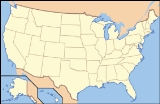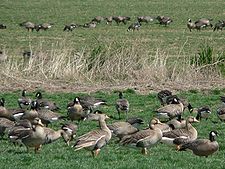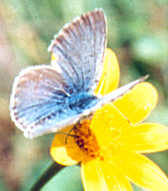
Baskett Slough National Wildlife Refuge
Encyclopedia


Oregon
Oregon is a state in the Pacific Northwest region of the United States. It is located on the Pacific coast, with Washington to the north, California to the south, Nevada on the southeast and Idaho to the east. The Columbia and Snake rivers delineate much of Oregon's northern and eastern...
, 10 miles (16 km) west of Salem
Salem, Oregon
Salem is the capital of the U.S. state of Oregon, and the county seat of Marion County. It is located in the center of the Willamette Valley alongside the Willamette River, which runs north through the city. The river forms the boundary between Marion and Polk counties, and the city neighborhood...
in Polk County
Polk County, Oregon
Polk County is a county located in the U.S. state of Oregon. The county is named for James Knox Polk, the 11th president of the United States. In 2010, its population was 75,403. The seat of the county is Dallas....
. Situated in open farmland near the eastern foothills of the Oregon Coast Range
Oregon Coast Range
The Oregon Coast Range, often called simply the Coast Range and sometimes the Pacific Coast Range, is a mountain range, in the Pacific Coast Ranges physiographic region, in the U.S. state of Oregon along the Pacific Ocean...
with the broad Willamette Valley
Willamette Valley
The Willamette Valley is the most populated region in the state of Oregon of the United States. Located in the state's northwest, the region is surrounded by tall mountain ranges to the east, west and south and the valley's floor is broad, flat and fertile because of Ice Age conditions...
and the Cascade Range
Cascade Range
The Cascade Range is a major mountain range of western North America, extending from southern British Columbia through Washington and Oregon to Northern California. It includes both non-volcanic mountains, such as the North Cascades, and the notable volcanoes known as the High Cascades...
to the east, elevations range from 185 to 414 feet (56 to 126 m) MSL
Sea level
Mean sea level is a measure of the average height of the ocean's surface ; used as a standard in reckoning land elevation...
. The Willamette Valley, with its mild, rainy winter climate, is an ideal environment for wintering waterfowl. The valley was once a rich mix of wildlife habitats with extensive wetlands, meandering stream channels and vast seasonal marshes. Today, the valley is a mix of farmland and growing cities, with few areas remaining for wildlife. The Refuge consists of 1,173 acres (4.75 km²) of cropland
Farm
A farm is an area of land, or, for aquaculture, lake, river or sea, including various structures, devoted primarily to the practice of producing and managing food , fibres and, increasingly, fuel. It is the basic production facility in food production. Farms may be owned and operated by a single...
, which provide forage for wintering geese, 300 acres (1.2 km²) of forest
Forest
A forest, also referred to as a wood or the woods, is an area with a high density of trees. As with cities, depending where you are in the world, what is considered a forest may vary significantly in size and have various classification according to how and what of the forest is composed...
s, 550 acres (2.2 km²) of grassland
Grassland
Grasslands are areas where the vegetation is dominated by grasses and other herbaceous plants . However, sedge and rush families can also be found. Grasslands occur naturally on all continents except Antarctica...
s, and 500 acres (2.0 km²) of shallow water seasonal wetland
Wetland
A wetland is an area of land whose soil is saturated with water either permanently or seasonally. Wetlands are categorised by their characteristic vegetation, which is adapted to these unique soil conditions....
s and 35 acres (0.14 km²) of permanent open water
Lake
A lake is a body of relatively still fresh or salt water of considerable size, localized in a basin, that is surrounded by land. Lakes are inland and not part of the ocean and therefore are distinct from lagoons, and are larger and deeper than ponds. Lakes can be contrasted with rivers or streams,...
. In 1965, Baskett Slough National Wildlife Refuge was created to help ensure some of the original habitat remained for species preservation. The refuge is managed by the U.S. Fish and Wildlife Service, an agency of the U.S. Department of the Interior.
Flora and fauna
As with the other refuges within the Willamette Valley National Wildlife Complex, the primary management goal of Baskett Slough National Wildlife Refuge is to provide high quality wintering habitat for geese, especially the Dusky Canada GooseCanada Goose
The Canada Goose is a wild goose belonging to the genus Branta, which is native to arctic and temperate regions of North America, having a black head and neck, white patches on the face, and a brownish-gray body....
(Branta canadensis subsp. occidentalis), so as to ensure healthy, viable goose populations while minimizing goose browse damage to crops on private agricultural lands. Unlike most other Canada geese, Dusky Canada Geese have limited summer and winter ranges. They nest on Alaska
Alaska
Alaska is the largest state in the United States by area. It is situated in the northwest extremity of the North American continent, with Canada to the east, the Arctic Ocean to the north, and the Pacific Ocean to the west and south, with Russia further west across the Bering Strait...
's Copper River
Copper River (Alaska)
The Copper River or Ahtna River is a 300-mile river in south-central Alaska in the United States. It drains a large region of the Wrangell Mountains and Chugach Mountains into the Gulf of Alaska...
Delta and winter almost exclusively in the Willamette Valley. Habitat loss, predation, and hunting caused a decrease in their population. Dusky Canada Geese usually appear at the Refuge in the fall and use it as their last stop before starting the spring journey back to their Alaska nesting grounds. During the winter of 2001, a survey found a total of 35,988 geese, swans and ducks in the refuge.
By resting in undisturbed areas on the refuges, wintering geese regain energy reserves required for migration and nesting. Because of their need for a quiet resting area, the majority of the refuge interior is closed to public entry while the geese are in residence, from October 1 through April 30.
The croplands, rolling oak-covered hills, grass fields, and shallow wetlands of the Refuge are home to many wildlife species. Cinnamon Teal
Cinnamon Teal
The Cinnamon Teal is a small, reddish dabbling duck found in marshes and ponds of western North and South America.thumb|left|Female Anas cyanoptera septentrionalium...
, Mallard
Mallard
The Mallard , or Wild Duck , is a dabbling duck which breeds throughout the temperate and subtropical Americas, Europe, Asia, and North Africa, and has been introduced to New Zealand and Australia....
s, Bufflehead
Bufflehead
The Bufflehead is a small American sea duck of the genus Bucephala, the goldeneyes. This species was first described by Linnaeus in his Systema naturae in 1758 as Anas albeola.-Description:...
and Hooded Merganser
Hooded Merganser
The Hooded Merganser is a small duck and is the only member of the genus Lophodytes.Hooded Mergansers have a crest at the back of the head which can be expanded or contracted. In adult males, this crest has a large white patch, the head is black and the sides of the duck are reddish-brown...
s are just a few of the duck species that are common during the winter months. Great Blue Heron
Great Blue Heron
The Great Blue Heron is a large wading bird in the heron family Ardeidae, common near the shores of open water and in wetlands over most of North and Central America as well as the West Indies and the Galápagos Islands. It is a rare vagrant to Europe, with records from Spain, the Azores and England...
s and other shorebirds feed along the waters edge. Red-tailed Hawk
Red-tailed Hawk
The Red-tailed Hawk is a bird of prey, one of three species colloquially known in the United States as the "chickenhawk," though it rarely preys on standard sized chickens. It breeds throughout most of North America, from western Alaska and northern Canada to as far south as Panama and the West...
s can be seen flying over the refuge and a small number of Bald Eagle
Bald Eagle
The Bald Eagle is a bird of prey found in North America. It is the national bird and symbol of the United States of America. This sea eagle has two known sub-species and forms a species pair with the White-tailed Eagle...
s winter on the refuge. In addition to the abundant bird life, 30 species of mammals, 8 species of amphibians, and 10 species of reptiles occur here. The largest remaining population of the endangered
Endangered species
An endangered species is a population of organisms which is at risk of becoming extinct because it is either few in numbers, or threatened by changing environmental or predation parameters...
Fender's blue butterfly
Fender's blue butterfly
Fender's blue is an endangered subspecies of butterfly found only in the Willamette Valley of northwestern Oregon, United States. The species was first noticed in the 1920s but wasn't scientifically documented and named until 1931 by biologist Ralph Macy...
is found on the refuge. Wildlife and wildlands observation, photography, hiking, and environmental education and interpretation are the major public use activities allowed on the Refuge.
Recreation
Visitor facilities include the Baskett Slough information and wildlife viewing kiosk, located on the north side of Oregon Route 22 about 2 miles (3.2 km) west of the intersection with Oregon Route 99W. About 5 miles (8 km) of walking trails include the year-round Baskett Butte Loop Trail, and the Morgan Lake and Inter-Tie Trails (open April 1 – Sept 30th). The refuge is only open during daytime hours and in keeping with the focus of habitat and wildlife preservation, no hunting or fishing is allowed.Recently, the refuge has increased efforts to restore and expand riparian, wet prairie
Prairie
Prairies are considered part of the temperate grasslands, savannas, and shrublands biome by ecologists, based on similar temperate climates, moderate rainfall, and grasses, herbs, and shrubs, rather than trees, as the dominant vegetation type...
, upland prairie and oak savanna
Oak savanna
An oak savanna is a type of savanna, or lightly forested grassland, where oaks are the dominant tree species. These savannas were maintained historically through wildfires set by lightning, grazing, low precipitation, poor soil, and/or fires set by Native Americans...
habitats. The oak savanna habitat on the Refuge supports the largest surviving population of the endangered Fender's blue butterfly which feeds upon the threatened
Threatened species
Threatened species are any speciesg animals, plants, fungi, etc.) which are vulnerable to endangerment in the near future.The World Conservation Union is the foremost authority on threatened species, and treats threatened species not as a single category, but as a group of three categories,...
Kincaid's lupine
Lupinus sulphureus
Lupinus sulphureus is a species of lupine native to western North America from southern British Columbia south through Washington to Oregon. It is a perennial herbaceous plant growing to 40-80 cm tall. The leaves are palmately compound, with 7-13 leaflets, the leaflets 2-5 cm long...
plant.
The Refuge was named for George J. Baskett, an early Willamette Valley settler, who was a thoroughbred horse breeder.

